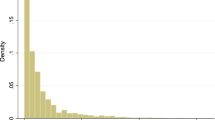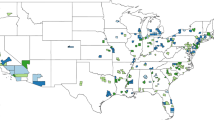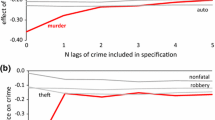Abstract
In the past few years, there have been numerous high-profile shootings by police, with wide-spread speculation many may have been either racially motivated or the result of an abuse of power by police. While past researchers have used community-level data to test theories of “racial or economic threat”—that police target violence at minorities or the poor to prevent redistributive criminal activity and maintain the existing order—or “reactive hypotheses” of policing focused on the use of force to prevent violence against officers and other citizens, the majority of these studies are dated, rely on incomplete government data on justifiable police killings, and fail to consider predictors of police killings such as non-murder violent offense rates, property crime rates, or violence against police. However, recently, many internet archives have collected more complete data on police killings, and this study utilizes one such source to create a county-level longitudinal dataset of police-related fatalities from 2000 to 2014 to estimate the causal relationship between changes in county characteristics and police-related fatalities. In addition to finding police-related fatalities are strongly correlated with murder rates, findings show substantial evidence that police-related fatalities are also strongly correlated with rates of property crime and assaults on officers, factors not previously considered. Contrary to previous research, this study finds little to no evidence in favor of the “racial or economic threat hypotheses” when examining police-related fatalities within county over time.

Similar content being viewed by others
Notes
While not a study analyzing geographic areas as a unit of observation, a well-known, controversial study by Fryer (2016) analyzes a handful of large cities to determine that Blacks and Hispanics are no more likely to experience an officer-related shooting in total or controlling for context and behavior. Criticism of Fryer (2016) tends to stem from the lack of available data pertaining to PRFs in interactions with police, the fact the small number of cities used may not be representative of the USA as a whole, and the fact he relied on arrest reports written by the officers themselves to determine whether each incident was one in which officers involved were justified in exercising deadly force.
Vehicle-related fatalities involving law enforcement can happen in multiple ways. In some cases, fatalities result from crashes caused by police chases where individuals flee police. In these cases, the fatally injured parties may be the fleeing parties and/or innocent bystanders. Alternatively, fatalities can occur due to accidents involving officers or in other circumstances be due to officer malfeasance.
This is examined by adding an interaction term between a linear time trend and each of the variables contained in X to Equation 3. The interaction is positive and statistically significant for the fraction Hispanic (P < 0.01) and negative and statistically significant for the fraction Asian and Pacific Islander (P < 0.01) and the fraction urban (P < 0.01).
Population estimates based on the 2000 and 2010 Census are taken from annual estimates as of July 1st of each year.
Another issue that arises when creating a longitudinal dataset of counties is that a handful of counties split, consolidate, cede land, or are created from existing areas over time. For example, Bedford City (VA), previously classified as an independent city and county-equivalent, was added to Bedford County (VA) in July 2013. Similarly, the independent city of Clifton Forge (VA) was added to Alleghany County (VA) in July 2001. In both cases, data for the aggregated area was analyzed throughout. Similarly, in the period studied the Skagway-Hoonah-Angoon Census Area (AK) split into the Hoonah-Angoon Census Area (AK) and the Skagway Municipality (AK); and the Wrangell-Petersburg Census Area (AK) split into the Petersburg Census Area (AK) and Wrangell City and Borough (AK). Again, in both cases, data for the aggregated area was analyzed throughout. Likewise, the Prince of Wales-Hyder Census Area (AK) was created from the remainder of the Prince of Wales-Outer Ketchikan Census Area (AK) after parts were ceded to the Ketchikan Gateway Borough (AK) and Wrangell City and Borough (AK). In this case, the Prince of Wales-Outer Ketchikan Census Area (AK) and Prince of Wales-Hyder Census Area (AK) were analyzed as the same unit over time. Additionally, Broomfield County (CO), created from parts of four separate counties in November 2001, is only analyzed from 2002 onward.
For county-year observations with no Black or Hispanic residents, the relevant dissimilarity indices are imputed at the county-level mean of the corresponding index.
Due to limitations in the data, the mean household income for Blacks or Hispanics is not disclosed for counties with too few members of each group. For county-year observations where a group’s mean household income was not disclosed, the estimate was linearly interpolated where possible. For those counties with too few observations to use this method, it was further assumed that the ratio of the group’s household income relative to Whites grows at the same rate as the sample of observed counties.
This includes ICPSR studies 06669, 06850, 02389, 02764, 02910, 03167, 03451, 03721, 04009, 04360, 04466, 04717, 23,780, 25,114, 27,644, 30,763, 33,523, 34,582, 35,019, 36,117, and 36,999.
Offense data is not available for all counties each year. For county-year observations missing offense data, crime data are linearly interpolated using figures from 1994 to 2014. For a handful of counties with no reports in this period, counties are matched to the three most similar counties in-state with reported data based on population and the fraction of the population in urban areas. State police offense data is not allocated to counties in Alaska, Connecticut, and Vermont. For these states, offenses are allocated based on county population. Similarly, the New Jersey Port Authority did not allocate offense data to counties, so offense data is allocated across the four covered counties based on population.
Counties with no PRFs over this period are not analyzed, since PRFs in these counties are fully explained by county-fixed effects and dropped from negative binomial regressions in the analysis.
For comparison, Appendix Table A1 shows means and standard deviations for counties in which no PRF is observed over the sample period. Statistical analysis reveals counties in which no PRF is observed are on average less populous, less urban, less racially and ethnically diverse, and more economically equal than counties with at least one PRF over the period. In addition, Hispanics in counties with no PRFs have higher household income and lower rates of segregation as compared to Whites. Furthermore, counties with no PRFs also have fewer female police officers and lower rates of officer assault, murder, non-murder violent offenses, and proper crime offenses.
Some studies in the literature estimate an ordinary least squares (OLS) regression using the dependent variable police-related fatalities per 100,000. However, since the underlying variable is distributed as count data, the non-normality and excessive number of zero values of the dependent variable make OLS misspecified.
A likelihood ratio test comparing the fully specified negative binomial regression model to a Poisson regression model indicates that the negative binomial regression model is more appropriate (Chi-square statistic 147.04, α statistically significant at the 1% significance level).
A robustness check of the main results that splits property crime into motor vehicle theft rates and rates of other property crimes finds that motor vehicle theft rates are statistically significant (P < 0.01) while rates of other property crimes are not (P > 0.1).
References
Allison PD, Waterman R. Fixed-effects negative binomial regression models. In: Stolzenberg RM, editor. Sociological methodology. Oxford: Basil Blackwell; 2002.
Fryer RG (2016) An empirical analysis of racial differences in police use of force. NBER Working Paper No. 22399. National Bureau of Economic Research, Cambridge.
Guimarães P. The fixed effects negative binomial model revisited. Econ Lett. 2008;99:63–6.
Jacobs D, O’Brien RM. The determinants of deadly force: a structural analysis of police violence. Am J Sociol. 1998;10:837–762.
Lichtblau E (2016) Justice Department to track use of force by police across the U.S. New York Times. https://www.nytimes.com/2016/10/14/us/justice-department-track-police-shooting-use-force.html?_r=0. Accessed 16 Mar 2017.
Lott JR. Does a helping hand put others at risk? Affirmative action, police departments, and crime. Econ Inq. 2000;2:239–77.
MacDonald JM, Alpert GP, Tennenbaum AN. Justifiable homicide by police and criminal homicide: a research note. J Crime Justice. 1999;22:153–66.
MacDonald JM, Kaminski RJ, Alpert GP, Tennenbaum AN. The temporal relationship between police killings of civilians and criminal homicide: a refined version of the danger-perception theory. Crime Delinq. 2001;47:155–72.
Peterson CE, Weden M, Shih RA (2017) Demographic, social, economic, and housing characteristics: Development of a U.S. contextual database of 1990–2010 measures. RAND Corporation, Santa Monica. https://www.rand.org/pubs/research_reports/RR1741.html. Accessed 31 Dec 2018.
Ross CT. A multi-level Bayesian analysis of racial bias in police shootings at the county-level in the United States, 2011–2014. PLoS One. 2015;10:e0141854.
Smith BW. The impact of police officer diversity on police-caused homicides. Policy Stud J. 2003;31:147–62.
Smith BW. Structural and organizational predictors of homicide by police. Policing. 2004;27:539–57.
Sorensen JR, Marquart JW, Brock DE. Factors related to killings of felons by police officers: a test of the community violence and conflict hypotheses. Justice Q. 1993;10:417–40.
Weden MW, Peterson CE, Miles JNV, Shih RA. Evaluating linearly interpolated intercensal estimates of demographics and socioeconomic characteristics for U.S. counties and census tracts 2001–2009. Popul Res Policy Rev. 2015;34:541–59.
Author information
Authors and Affiliations
Corresponding author
Ethics declarations
Conflict of Interest Statement
The authors declare that there is no conflict of interest.
Additional information
Publisher’s Note
Springer Nature remains neutral with regard to jurisdictional claims in published maps and institutional affiliations.
Appendix. Summary of county-level longitudinal data for counties with no police-related fatalities, 2000–2014
Appendix. Summary of county-level longitudinal data for counties with no police-related fatalities, 2000–2014
Mean (1) | SD (2) | Mean (1) | SD (2) | ||
|---|---|---|---|---|---|
Police-related fatalities (PRFs) | 0.000 | 0.000 | Poverty rate | 0.157 | 0.068 |
Population (1000s) | 16.00 | 16.42 | Land area (sq. mi)/1000 | 1.044 | 1.795 |
Log population | 9.22 | 1.04 | Fraction urban | 0.235 | 0.262 |
Black | 0.061 | 0.131 | Officers per 100,000 | 199.34 | 263.10 |
Hispanic | 0.069 | 0.130 | Fraction officers female | 0.058 | 0.073 |
Native American or mixed race | 0.033 | 0.094 | Officer assaults per 100,000 t-1 | 7.98 | 25.87 |
Asian or Pacific Islander | 0.006 | 0.024 | Officers killed per 100,000 t-1 | 0.016 | 0.503 |
Black-White mean HH income ratio | 0.623 | 0.658 | Murders per 100,000 t-1 | 2.928 | 9.365 |
Hisp.-White mean HH income ratio | 0.566 | 0.388 | Other violent crimes per 100,000 t-1 | 207.67 | 297.04 |
Black-White dissimilarity index | 0.588 | 0.173 | Property crimes per 100,000 t-1 | 1771.54 | 2689.79 |
Hispanic-White dissimilarity index | 0.446 | 0.160 | Number of counties | 1127 | |
Gini coefficient | 0.432 | 0.037 | Number of observations | 16,905 |
Rights and permissions
About this article
Cite this article
Kopkin, N. Where and When Police Use Deadly Force: a County-Level Longitudinal Analysis of Fatalities Involving Interaction with Law Enforcement. J Econ Race Policy 2, 150–162 (2019). https://doi.org/10.1007/s41996-019-00027-z
Received:
Revised:
Accepted:
Published:
Issue Date:
DOI: https://doi.org/10.1007/s41996-019-00027-z




